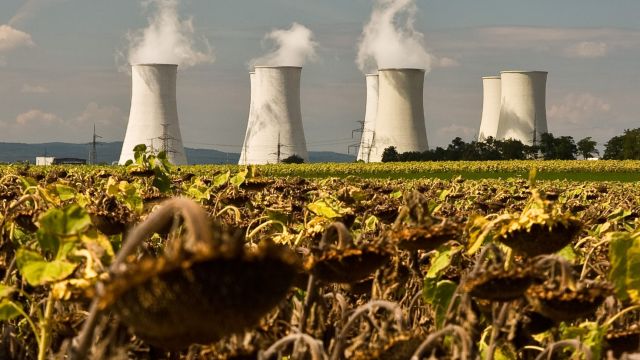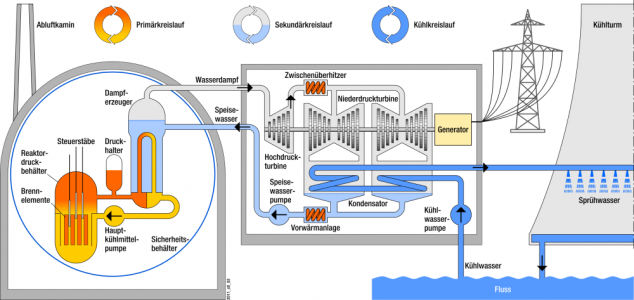
Built close to water – do increasing droughts and hot spells affect nuclear power plants?
Why does an NPP need cooling water?
In all NPPs operated worldwide, the energy generated in the reactor is converted into electrical energy in the turbine-generator set.
In the turbine, this conversion is achieved by expanding steam, coming from the reactor or steam generators at high pressure, into a condenser where there is negative pressure.
The steam flow from the inlet of the turbine to the condenser then causes the turbine shaft to rotate via specially shaped blades. The greater the pressure difference between the turbine inlet and the condenser, the more effective the energy conversion. In order to achieve a correspondingly low pressure in the condenser, a lot of cooling water is needed there. Due to the physical conditions, the efficiency of steam turbines only reaches 30 to 50 percent.
Heat can be released into the environment via cooling towers
This requires a large amount of cooling water, which is why NPPs are usually built on a river or seashore. If there is enough cooling water, the water from the river or sea can be pumped directly through the condenser and the heat is discharged into the river or sea. If the amount of cooling water available is not sufficient, cooling towers are used in which the heat is released into the atmosphere:
The water heated in the condenser is distributed in the cooling tower via nozzles. During this process, part of the water evaporates and rises upwards due to the chimney effect.
Here, only the water loss resulting from the evaporation has to be compensated from the body of water (river or sea). Here, only the water loss resulting from the evaporation has to be compensated from the body of water (river or sea).
A special type of cooling is the so-called discharge cooling. Here, the cooling water is taken from the body of water, pumped through the condenser into the cooling tower, where it is already cooled down somewhat and then fed back into the body of water. This significantly reduces the heat input into the body of water. Mixed operation is also possible here where part of the cooling water is pumped back into the condenser and another part is discharged into the body of water.
This basic rule always applies: the higher the cooling water temperature, the lower the negative pressure in the condenser and the worse the energy conversion in the turbine.
The same principally applies to any steam turbine power plant
In principle, every power plant in which a steam turbine is used to generate electricity has such a cooling water circuit. Accordingly, coal-fired or gas-and-steam combined cycle power plants must also be shut down during heat and/or drought.
But why is this the case? The assumption is that the cooling of the plant would no longer be ensured due to the heated or no longer available water, or that the power plants would pump out so much water that they would completely dry up the rivers. However, neither of these is the case. Rather, it is the case that ecological arguments are decisive for the power reductions.
Power reduction during heat spells: ecological aspects are crucial
For example, environmental regulations require that the river temperature downstream of the power plant and the temperature of the water that is discharged back into the river or the sea do not exceed certain limits. This is to ensure that the fauna and flora are protected and that the ecological system is not thrown out of balance. If it is foreseeable that such limit values will be reached, the power plant's output must be reduced in order to reduce the amount of cooling water required or not to heat the cooling water too much.
These limit values differ – and not only in a national comparison. Discharges into seas, for example, are generally allowed to be warmer than into rivers since the heated water is better distributed in the sea. However, there are also differences between rivers: for example, stricter requirements apply to the Isar than to the Weser since cooler temperatures are specified as limits for the mountain river Isar.
Work of GRS on this topic
GRS has investigated the effects of extreme weather events (including hot spells) on the operation of nuclear power plants several times in the past - among others in the research project investigating extreme weather events and weather conditions (German only). In addition, the experts regularly evaluate such events for the Federal Ministry for the Environment.
The result: longer periods of heat do not pose a serious safety problem because they can usually be predicted relatively far in advance and the water temperatures only rise slowly. Countermeasures can therefore be initiated at an early stage, such as shutting down the plant or reducing its output and ensuring that sufficient cooling water is available.
It should also be noted that the safety systems in an NPP, such as the emergency diesel generators, must also be cooled in case of demand. When designing the cooling systems, certain maximum values were specified for the cooling water. It must therefore also be checked whether these design values are complied with.
However, hot spells can cause losses in the generated output of NPPs – and power plants with steam turbines in general – resulting in less electricity being produced.

